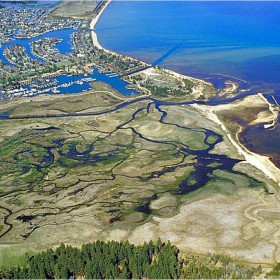Published: Sep 18, 2014

Conservancy Staff Unveils Preliminary Upper Truckee Marsh Restoration Alternative – Board Grants $300,000 towards Aquatic Invasive Species Activities
South Lake Tahoe, Calif. – September 18, 2014 – After decades of study, environmental review, and public comment, California Tahoe Conservancy staff announced today its preferred approach to restoring and improving the Upper Truckee Marsh. The Marsh’s flat expanse serves as a last defense and natural filter, cleansing nearly 40% of the water that enters Lake Tahoe.
“The preliminary alternative basically recreates the most natural floodplain in the middle of the marsh, with no action on the east side and improved recreation amendments on the west side,” says Victoria Ortiz, Communications Liaison for the Conservancy.
Many neighbors voiced their support of the restoration plan, while commenting on the increased need for ongoing maintenance.
“They (the public) support that alternative and that’s important to me,” said Conservancy Board member Tom Davis.
“I can generally say that we do endorse the alternative being presented today,” said Greg Poseley, Coordinator for the Al Tahoe Neighborhood Partners, “though enforcement is still a big issue out there.”
Shawn Butler, Land Management Program Coordinator, described current management activities on the Marsh including regular and targeted patrols and inspections, prioritizing Upper Truckee Marsh maintenance projects, collaboration with partners, and the option to explore additional law enforcement.
“Following the July Board Meeting we heard and have actively responded to neighbor and public concerns,” says Shawn.
Staff anticipates returning to the Board with a final recommended alternative in 2015 after additional review. The earliest possible construction date is 2017.
The Conservancy Board also announced today that it will invest $300,000 towards programs to plan and control the spread of warm water fish, exotic plants, and other aquatic invasive species.
“Aquatic invasive species threaten our lake’s health, clarity and aesthetic value,” said John Hooper, Vice Chair of the Conservancy Board. “We support our partner’s efforts towards eradication.”
Penny Stewart, the Conservancy’s Natural Resources and Public Access Program Manager, explained during her presentation that “owners of lakefront piers or other structures on Lake Tahoe pay a fee for use of the State’s public trust lands. Until now, those fees had never been spent in the Basin.”
The Conservancy worked with lakefront homeowners to pass legislation that redirects the revenue from those fees from the state’s general fund to nearshore projects in the Tahoe Basin. Now $150,000 from these fees, together with $150,000 of the Conservancy’s own funds, will finance nearshore aquatic invasive species projects or public access projects, and nearshore water quality monitoring.
Established in 1984, the mission of the Tahoe Conservancy is to lead California’s efforts to restore and enhance the extraordinary natural and recreational resources of the Lake Tahoe Basin. For more information, visit https://tahoe.ca.gov.

